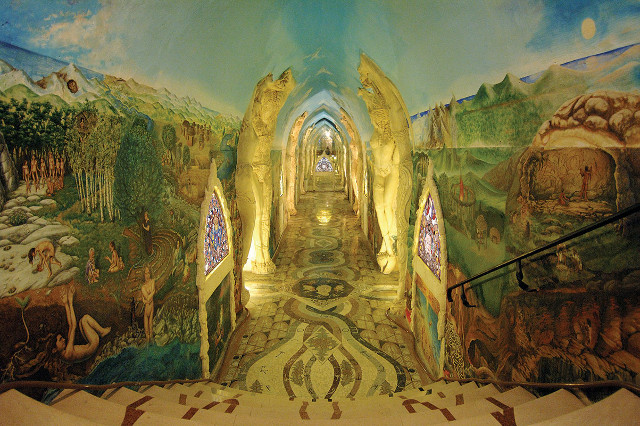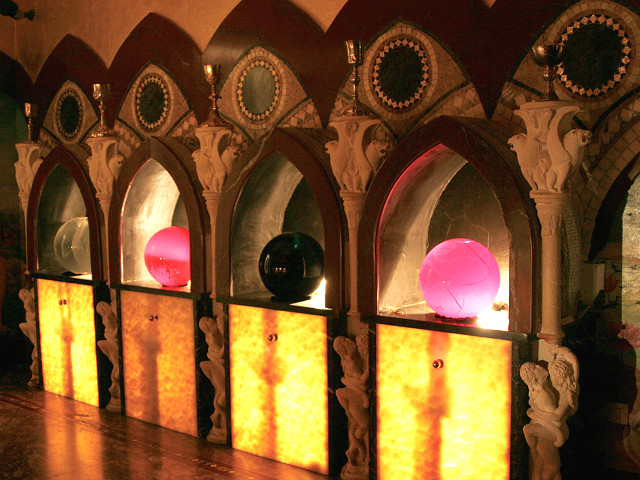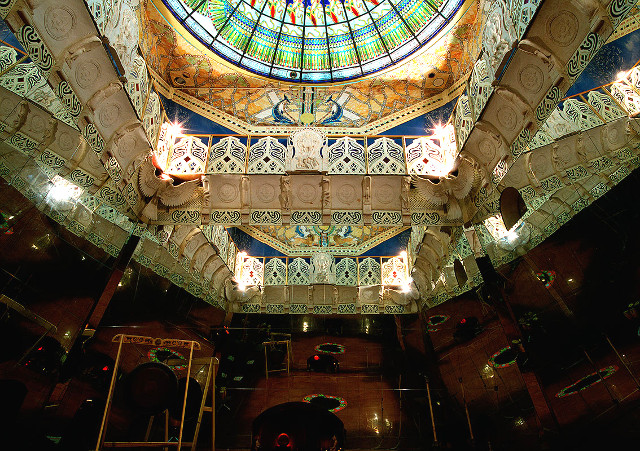After nearly a month in Damanhur I finally go to the underground Temples. When I come out of there my head is pretty much empty for awhile. How can I even begin to attempt to describe the experience with words? It’s not a word kind of place. Well, actually I do have words.
Two of them: Go There!
Aside from that, if you want to get a feel for the Temples, it’s better to have a visual input. You might explore website for Damanhur’s Temples of Humankind and take the virtual tour. Or get a hold of Dreams of Damanhur by Keith Busha. This is the DVD that inspired me to come here in the first place, and it captures the essence of the Temples far better than black words on a white page can. I won’t focus much on general descriptions of the Temples, just some of the aspects that moved me.
When I enter the Temples of Humankind I feel a sense of awe that dissipates the words right out of my head. My own skull becomes an empty container for vast and interpenetrating images. Consider the soul of Michelangelo returning to earth, dividing itself into a group of dedicated folks in order to create this contemporary miracle of Spirit, Art and Passion.
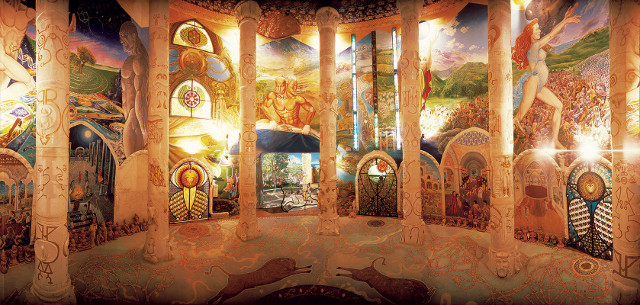
Not only this, but to do it underground, digging into solid rock, and initially in secret. It was Michelangelo, after all, who said that sculpture was an act of liberating the angel from within a block of stone. And when I look up at the intricate mandala-like stained glass ceilings, what resonates is the Sistine Chapel (not so much in similarity as in effort and beauty). Surely I am looking up into a place that reaches into the heavens. But wait, we are not even touching the sky. We are underground and the ceiling glass is illuminated by subterranean lights. This in itself shifts my experience of time and space. I have the sense of being “as above, so below” in the same instant.
All the temples seem to blend together in my memory now, making an accurate description difficult. The Hall of Earth, the Hall of Metal, the Hall of Water, The Hall of Spheres, the Hall of Mirrors. Each one has its own message and presence (and one might venture to say…it’s own“entity”). Many of the floors are embellished with mosaics as the ceilings are with stained glass.
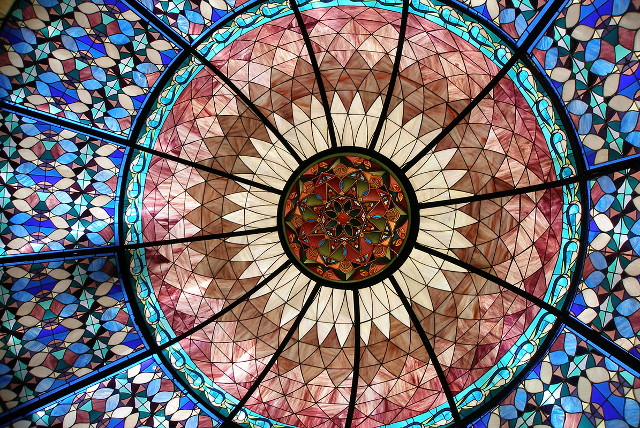
The walls of some temples are covered with paintings of landscapes, seasons, elements, and stages of humankind, both individually (childhood to old age) and collectively (evolutionarily and historically). There are paintings of the citizens of Damanhur, and as I look around I recognize some of them. There’s Salamandra, for instance, depicted as a wise elder giving council to a group of others.
The dandelion is the flower of Damanhur (yes, the very one that we consider a weed). And in several places I see painted and mosaic dandelions in various stages of growth: from leaf to bud to blossom and finally to seed-freeing fluff.
There are also stained glass doors positioned in four corners of one temple, representing the elements of fire, earth, air and water. These are actually closet-like rooms, illuminated from within, each containing altars. There are similar stained glass enclosed altars in some of the other temples too. And if I remember correctly, at least one of them houses a secret door. Among many secret doors. Seemingly doorless walls turn aside when pressed in the right place.
There is also a persistent growling sound coming from somewhere within the walls around us. It’s not a Minotaur hungrily waiting gobble us up in the center of the labyrinth. “This is the constant music of the Temples,” says Platypus, our gentle-mannered guide. It’s the sound of machinery, perhaps a drill or saw, of the creation always in process.
There’s even a woman painting images onto a blank space on a temple wall right as we pass.
One of my favorite temples is The Blue Temple. It’s small and round with a large glass sphere of blue water on the altar. There’s also a beautiful mosaic floor depicting the tarot Star card. I have to tell you that the Star is my favorite tarot card. It’s my guiding card. And, intriguingly, this star goddess mosaic is very similar to my own painted versions of her that I’ve done. She’s got one hand reaching up, gathering water from the heavens, and the other reaching down, pouring water onto the earth.
Platypus tells us that if we each stand right on the heart of the star lady and speak, we’ll hear our voices echoing back to us. It’s the only place in this room where one can do this. I stand on the the center of the star goddess’s chest and recite: From the heart of the Star, I hear the echo of my soul. And amazingly enough, my own voice, smaller and strangely disembodied, speaks back to me. Don’t ask me how they do this.
I’m not about to break the magic spell by firing off a lot of questions.
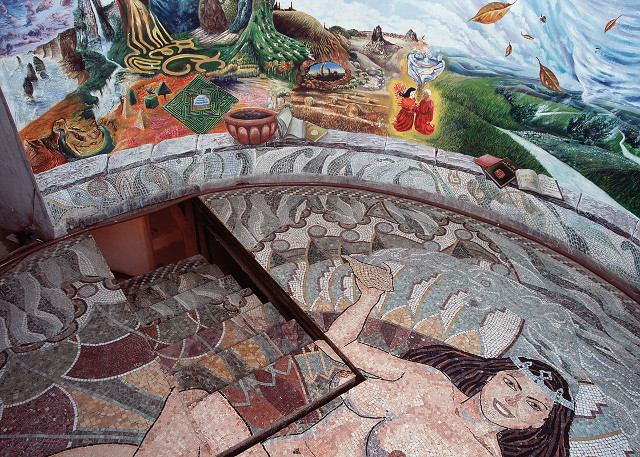
The next thing I know, part of the star goddess is moving. A small trap door opens up and we descend stairs into further depths below. I remember as child how I always loved fun houses, or spook houses as we sometimes called them. I loved the meandering, shadowy labyrinths that opened up into various chambers rendering mysterious images and archetypes. And now I am walking through narrow hallways painted with Egyptian figures. I watch doorways emerge from the walls and slip thorough trap doors into other rooms. I enter chamber after chamber so full of images I can’t possibly digest them all. So I just breathe and absorb them as I go.
My next favorite temple is the Hall of Water. It’s the temple “of life, death, dreams, knowledge and memory.” The dolphin mosaic floor reminds me of the one I saw in the House of Dolphins on the island of Delos in Greece many years ago. That mosaic, which had been partially destroyed by time, brought tears to my eyes. I’d felt a strange sense of sadness for something long lost.
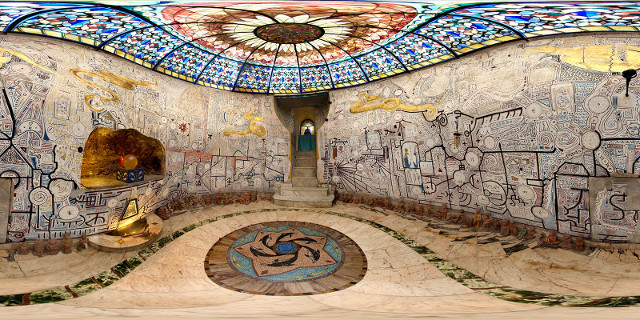
Now, being here, I understand that what felt lost is being found. A teardrop glimmer of recognition on Delos has become an ocean. I am not so much learning things that are new here. No, the beauty is in the deep recognition that I feel, the sense of so many things and paths I have loved in my life converging into one. And it’s not just in the Temples alone, but in Damanhur as a whole. Only the Temples accentuate this feeling, as they delve into the mysterious interiors of being.
The Hall of Water is shaped like a cylinder. It’s walls, painted in background white, host patterns of spirals, lines, geometrics, serpents, circles, and sacred language all done by Falco. There are also names of several deities from various religions and mythologies. These drawings and words are specifically intended to evoke ancient memories and knowledge, being a sacred library of sorts.
There is a sphere filled with blue liquid in this temple. And another with clear liquid with a red candle flickering behind it. This flame is apparently always kept lit. Platypus runs his hands through a circle of hanging wind chimes, creating a ringing spiral before we depart.
When we come to a series of hallways called the Labyrinth, my mythology-loving soul is ecstatic. Here are walls and walls of intricately stained glass windows, each lit from within. Each window depicts a major mythological deity from every part of the world. The major religions are also included.
While I was growing up, I remember staring at colorful stained glass windows during the Catholic mass. Now I have the pleasure of gazing at windows of some of my favorite sacred beings: Pan, Persephone, Ganesha, Bast, Amaterasu, Pele, among so many others.
The Hall of Spheres is also interesting. It’s a small, rectangular room with fluid-filled spheres lined up and housed in separately carved spaces. They are apparently filled with alchemical fluids. I love the colors of this room, the deep, red marble, the ceiling which is painted in gold leaf. It reminds me of the palace of Minos in Crete, at least how I remember it from years ago.
Then there’s the Temple finale: the Hall of Mirrors. I don’t recall the details of this room other then the large mirrored walls and ceilings. The lighting is dim and gongs of different sizes line the perimeters of the room. Seated on chairs in the center, we listen as Platypus strikes each gong in turn, creating a deep, booming resonance throughout the temple.
This Hall “celebrates the awakening of the complete human being,” says Esperide Ananas in Damanhur: Temples of Humankind, a beautiful, picturesque book which I consult after my visit. “An ancient myth, dear to the Damanhurian tradition, describes the divinity as a mirror that must shatter into infinite fragments in order to enter the material world…. Seeing ourselves reflected here reminds us of our divine origin.”
What can I say? That pretty much sums it up. For me at least, as I have never before experienced so many fragments of myself reflected to back to me. I think of the the restless and often anxious energy I felt before coming here, as if my own frequency was displaced. Now I feel my frequency matched and encouraged. The anxiety has shifted levels, becoming more focused and charged.
When I’ve asked some of the people here if they minded working so much, they’ve told me that they feel more energy just by being here. They are not working long hours at a less than satisfying job in order to make a living so they can do other things. They seem to love what they are doing and what they are working for. They are plugged into a greater purpose, a morphic resonance, a growing global entity that the Temples themselves concentrate and express.
When I finally leave the Temples, my thoughts are still and calm. I am savoring the fragrance of the mysterious depth of the rose. I also feel more confident about my own creative gifts. These people are doing amazing things here. And now I’m riding the wave along with them. I have faith that there is a place for me, for my contribution, whether it’s here or somewhere else in the world. My guide the Star goddess moves with me beyond the Temple walls and back to the upper world.
by Ann Marie Molnar
